

The Secrets to the VCS's Longevity
By Scott Stilphen
| SECTIONS |
| Programming Tricks |
| Bank-Switching |
| Chip-On-Board (COB) Technology |
| "Super Chips" |
| "Super Cartridges" |
| Miscellaneous |
| The Future |
When the fabled Atari Video Computer System (VCS) was released in 1977, the technology contained within it was fairly cutting-edge stuff. Designs for the system were sketched out less than 2 years before, by Atari's Cyan Engineering group, in December 1975. This is before the 6502 processor - of which the VCS's 6507 processor is a variant of - was even available at the time! Its custom graphics chip, the Television Interface Adaptor or TIA, was proprietary to Atari and was the equivalent of 10,000 transistors (in comparison, the 6502 was the equivalent of approximately 3,500 transistors). This is the chip that was code-named "Stella" during its development, and was created by famed IC designer Jay Miner. In their effort to keep the system's final costs in check, many features were left out. For example, the 6507 was basically a cheaper version of the 6502. As Larry Kaplan explained in the documentary, "Stella at 20", the things the VCS designers left out were the changes that gave the VCS the incredibly long lifespan that it's enjoyed all these years. The most significant 'exclusion' was the lack of a frame buffer, meaning programmers had to 'draw' every frame of every screen in what's colloquially referred to as 'racing the beam'. This was less a stroke of genius on the part of the engineers (who were certainly geniuses in their field) and more a result of cost-cutting efforts to keep the console's price affordable. None-the-less, that design 'quirk' opened up a world of creativity and allowed for games to run incredibly smooth and fast at a level even competing systems like the Intellivision and Colecovision couldn't match years later.
Like most video game consoles at the time, the VCS was a "closed" system and not designed to be upgraded. Dedicated systems were still very popular, but they had a very short 'shelf life', so the VCS designers never expected the VCS to remain popular beyond its first year. Early on, its design predicated that it be able to play ports of Atari's popular arcade games such as Tank and Pong. Game ROM size was initially limited to 2K, but later expanded to 4K by the time the VCS was a year old (with the first game to utilize it being Hangman).
In spite of some design regrets (such as being limited to 128 bytes of RAM and 4K of ROM, and having a cartridge port w/o any read/write or clock lines), programmers often surpassed what the original designers thought the system was capable of. Bob Whitehead was responsible for a number of early programming breakthroughs, whether it was with using registers as general RAM storage to give himself 3 more bits of RAM in Star Ship, rewriting copied player graphics on the fly in Blackjack, or creating what became known as the Venetian blinds trick that made Video Chess possible. David Crane took Bob Whitehead's 6-character display technique from Blackjack and used it for a 6-digit score counter in Laser Blast; he later adapted it to move across the screen, making Dragster the 1st game to show a moving 6-character object.
Countless other tricks were either developed or adapted from other applications for the VCS. As games became larger in size and complexity, programmers devised better methods of dealing with the system's limitations, particularly with the dreaded flickering graphics.
Although the system was limited to 2 octaves and mono output, the TIA chip was designed with stereo output in mind, and those who modify their systems to take advantage of that will appreciate some of the stereo output offered by 4 of the 9 launch titles (Combat, Air-Sea Battle, Indy 500, and Street Racer), as well as the system's first 'killer app' - Space Invaders. Digitized voice was later implemented in 2 games - Open Sesame and Quadrun.
Games using 8K or more require a programming technique called bank-switching (patent 4,368,515 and patent 4,432,067). Bank-switching increases the amount of a system's usable memory beyond the amount directly addressable by the processor. The programming technique was known about since 1971, as it was discussed in C. Gordon Bell and Allen Newell's book, Computer Structures: Readings and Examples. In the case of the VCS/2600, the system's inherent cartridge ROM limit is 4K. Larry Wagner and Bob Whitehead's development of Video Chess also led to the use of bank-switching on the VCS. Atari's Asteroids was the first game released to use bank-switching, resulting in an 8K ROM. Unfortunately, even with the huge success of Asteroids, Atari was slow to accept the higher cost of using larger ROMs, and finally agreed to after the backlash it received over Pac-Man. By the following year (1983), all 'A-list' titles used ROMs of at least 8K. Other companies soon learned from Atari's mistake and started using bank-switching by 1983 as well; most companies simply used Atari's method for bank-switching. Activision developed their own method (for Decathlon and Robot Tank), as did Parker Brothers and Tigervision. Activision called theirs a "Subroutine Controlled Bank Select" chip. It was developed by David Crane and Jesse Cable. The chip provides automatic memory bank switching for any 6502 multiple-bank ROM system. In place of complex software bank switching logic, this hardware performs the function automatically in the span of a subroutine's stack operation.
Here's a list of
the various bank-switching methods that were created during the VCS's active
lifespan:
CV (Commavid 2K + 1K of RAM)
F8 (Atari 8K)
F8SC (Atari 8K + SARA chip)
F6 (Atari 16K)
F6SC (Atari 16K + SARA chip)
F4 (Atari 32K)
F4SC (Atari 32K + SARA chip)
SCABS "FE" (Activision 8K)
E0 (Parker bros. 8K)
3F (Tigervision 8K)
FA (CBS 12K + 256 bytes of RAM)
E7 (M-network 16K)
F0 (Megaboy 64K)
JANE (Wickstead Design 16K)
WD (Wickstead Design 8K + 64 bytes of RAM)
WF8 (Coleco 8K)
UA (UA Ltd 8K)
From David Crane:
| "The Atari 2600 could access 4K bytes natively. Bank selecting multiple (or larger) ROMs was known in the industry, although Atari was the first to do it in a game cartridge. At Activision I developed a pretty cool automatic bank switching system I called SCABS. SCABS (I know, disgusting acronym) stood for Subroutine Controlled Automatic Bank Switching. The game code could make subroutine calls between banks, and the circuit detected the operation and performed a bank switch between the JSR instruction and arrival at the destination. All other bank switching systems require overhead processing that made them a pain to use. For example, every bank of the ROM has to have a small area of duplicate code to jump into, change banks, and jump out of so that the CPU is not executing code that switches with the bank. SCABS could automatically access 8 banks of 4K, bringing the total memory from 4K to 32K bytes. We used this system briefly for (I think) Robot Tank and Decathlon. It required an external timing resistor on the PC board, so you can tell by looking at the board. Adding a resistor cost a nickel (not to mention the extra circuitry in the ROM). Once Atari somehow got a patent on the use of bank switching in a game cartridge, they offered it for a nickel per cartridge royalty. That made it cheaper for all of us and SCABS was abandoned." |
Chip-On-Board (COB) Technology
Adding extra chips to a cartridge comes at a price, both in the cost of adding extra components and the limited "real estate" a standard cartridge shell offered. One option would have been to simply make a longer or larger cartridge shell, but again there's considerable cost in doing so, even for a company like Atari who had been using the same shell since the system's debut. The solution came, not with making things larger, but making them smaller.
Up until then, cartridges used one or more IC (Integrated Circuit) chips in a typical DIP (dual in-line package), the type normally seen in most arcade and home video games (starting with Computer Space and Pong in the early 1970s):
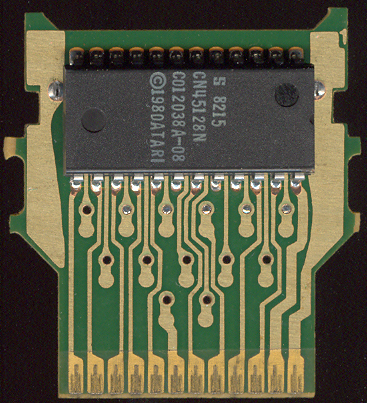
Typical VCS cart PCB with a 4K (DIP) ROM
In 1982 the Atari VCS was host to a new form of manufacturing technology in electronics with something called COBs, which is an abbreviation for Chip-on-Board. COB technology is an offshoot of the Flip Chip-on-Board (FCOB) technology that was originally developed by IBM in 1961 (under the name "C4", for Controlled Collapse Chip Connection). Both are an advancement over the typical IC DIP (dual in-line package).
Instead of DIPs that houses the actual chip die, the bare chip is mounted directly onto a printed circuit board (PCB) using the tape automated bonding (TAB) process. After the wires connecting the chip to the board are attached, a glob of epoxy or plastic is used to cover the chip and its connections:
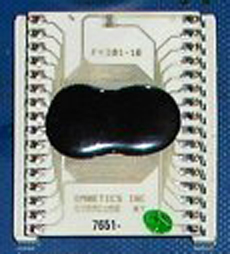
Universal Research Labs (URL) 1976 INDY 500/Speedway (AKA Video Action IV) showing the F-4301 2-chip module
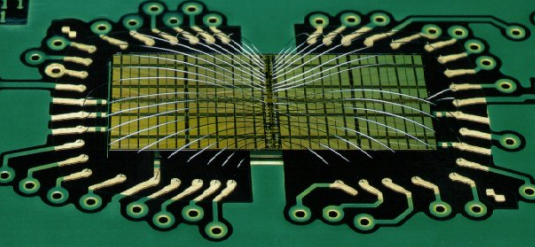
Photo of a bare chip die before being covered with epoxy or plastic

Several examples of Atari-made VCS PCBS having COBs in different packages
Using COBs has a number of advantages over an IC - the most beneficial being cheaper and faster to manufacture. They were also helpful in deterring software piracy. Ronald Borta of Roklan Corp. mentions (at the 52 minute mark of this podcast with Kevin Savetz) the company worked with General Instruments to create COBs for them for that reason. Longtime pirate Randy Crihfield (of Hozer Video Games) thinks COB pcbs are early prototype production runs of games (LINK), which couldn't be further from the truth, since they're really nothing special and were used by several companies, from huge companies like Atari and Mattel to a small outfit like Mythicon and ZiMAG.
According to an interview with former 3rd-party software company Mythicon programmer Bruce de Graaf, the only noteworthy item about the company was their use of COB for their games, which is how they were able to price their games so low ($9.95). It gave Mythicon a manufacturing cost advantage, with each cart costing less than $1 each, whereas it cost Atari $13; Atari was using COBs with its cartridge production as far back as Pac-Man in May 1982 (article), but of course never passed on the savings to their customers.
Mattel was another early adopter of the technology. Although their initial cartridge releases used DIP-style pcbs, most every game released after that used COB-type pcbs, as did re-releases of their earlier titles.
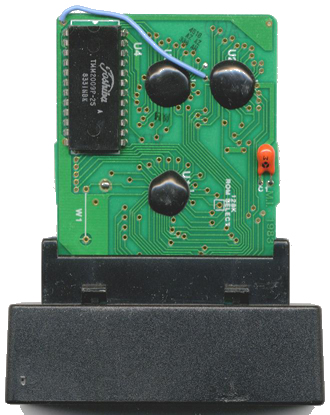
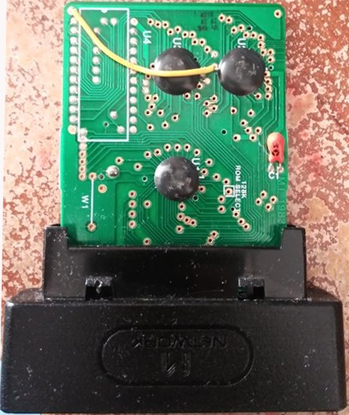
M Network's BurgerTime and
Masters of the Universe: The Power of He-Man pcbs in COB style
Another advantage to using COBs was to obfuscate the ROM chips themselves. Mattel took advantage of this when designing their Intellivision System Changer device. Contrary to statements on the Intellivision Lives website, the Atari VCS is not comprised solely of "off the shelf" hardware - the TIA being the most significant example of how it isn't. While Mattel boasted that Atari never sued Mattel over the System Changer, Mattel knew full well how difficult it would have been for Atari to prove Mattel was copying the TIA by using COB technology.
Starting in 1983, a few companies (Activision, Atari, CBS Electronics, CommaVid, Mattel, and U.S. Games) developed special RAM chips or "Super Chips" (co-processors) for certain games:

Activision's Pitfall II: Lost Caverns
pcb with the DPC chip (at bottom)
Activision had the Display Processor Chip or DPC. David Crane developed the special co-processor chip (patent 4,644,495, which was granted on February 17th, 1987), along with Jesse Cable. 'DPC' has duel meaning - Crane's full name is David Patrick Crane. According to Crane, "The DPC chip added more graphic capability as well as 3 channel music (plus drum), and made Pitfall II: Lost Caverns possible. Unfortunately, the 2600 business died before any other games could take advantage of that technology." Crane also offered a more-detailed explanation as to how it works (link). DPC contains a number of features that were not used in Pitfall II - ways to read data fetchers with nybbles swapped, bytes reversed, rotated, etc. Since no games ever used them, they haven't been emulated.
There's been some discussion about the pitch of the music generated by this chip, and how different carts will play the music at different pitches. Turns out, on the cart, the frequency is determined by a resistor (560K ohms) and a capacitor integrated onto the die of the DPC chip itself. The resistor is a 5% tolerance part, and the process variations of the DPC itself will control the frequency of the music produced by it. If you touch the resistor on the cartridge board, the music pitch will drastically change, almost like you were playing it on a theremin! Lowering the resistance makes the music pitch increase, increasing the resistance makes the pitch lower. It's extremely high impedance, so body effects of you touching the pin makes it vary wildly. Thus, I say there's really no "one true" pitch for the music. The patent, however, says that the frequency of this oscillator is 42KHz in the "preferred embodiment". The patent says that it can range from 15KHz to 80KHz depending on the application and the particular design of the sound generator; 21KHz (half their preferred value) sounds fairly close to an actual cartridge.
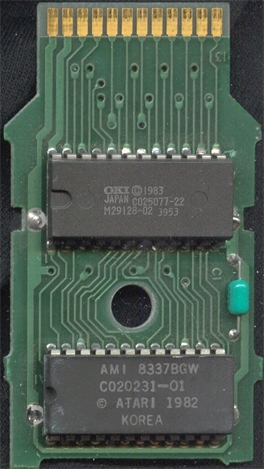
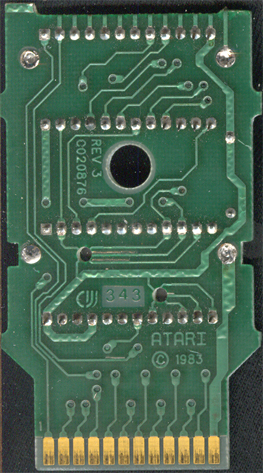
Atari's Dig Dug pcb with the SARA chip (at
bottom - CO20231-01), which were manufactured by AMI, IMP, OKI, and TSU
Atari called theirs SARA and it added 128 bytes of RAM. 14 games were released between 1982 - 1984 that used the SARA:
Atari released 14 games that used the SARA - only 4 of those being released in Atari Inc.'s final year (late 1983 - early 1984).
Elevator Action (8K) prototype
Stargate / Defender II (8K)
Crack'ed (16K) prototype
Crystal Castles (16K)
Dark Chambers (16K)
Desert Falcon (16K)
Dig Dug (16K) - 1st SARA-enabled game
Jr. Pac-Man (16K)
KLAX (16K)
Millipede (16K)
Off The Wall (16K)
Radar Lock (16K)
Save Mary (16K) prototype
Secret Quest (16K)
Shooting Arcade (16K) prototype
Sprint Master (16K)
Super Football (16K)
Fatal Run (32K)
Both Garfield and Zoo Keeper were to use the SARA chip as well. The following homebrew games also use the SARA:
The Byte Before Christmas (32K)
Cave In (32K) 1st homebrew to use SARA
Chetiry (uses SARA for the high score table)
Escape It!
I don't know if any of Atari's SARA-chip games used COBs; considering Atari Corp. was still releasing some DIP cartridges up until the end. It's hard to imagine a cheapskate like Jack Tramiel wouldn't have used COB technology more to save money, but then again, he owned his own chip fabricating company, so the savings to him would have been negligible.
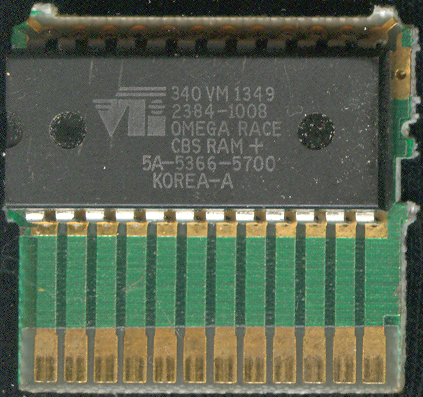
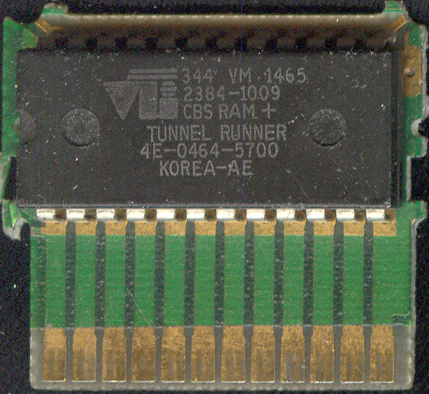
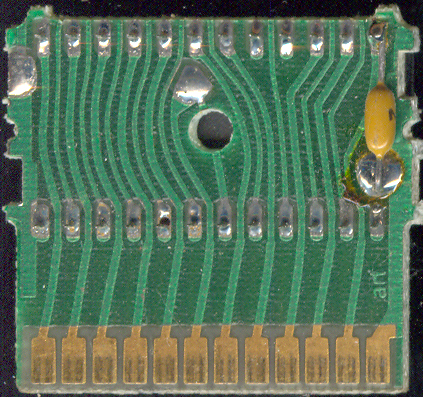
CBS Electronics' RAM Plus chip for Omega Race and Tunnel Runner
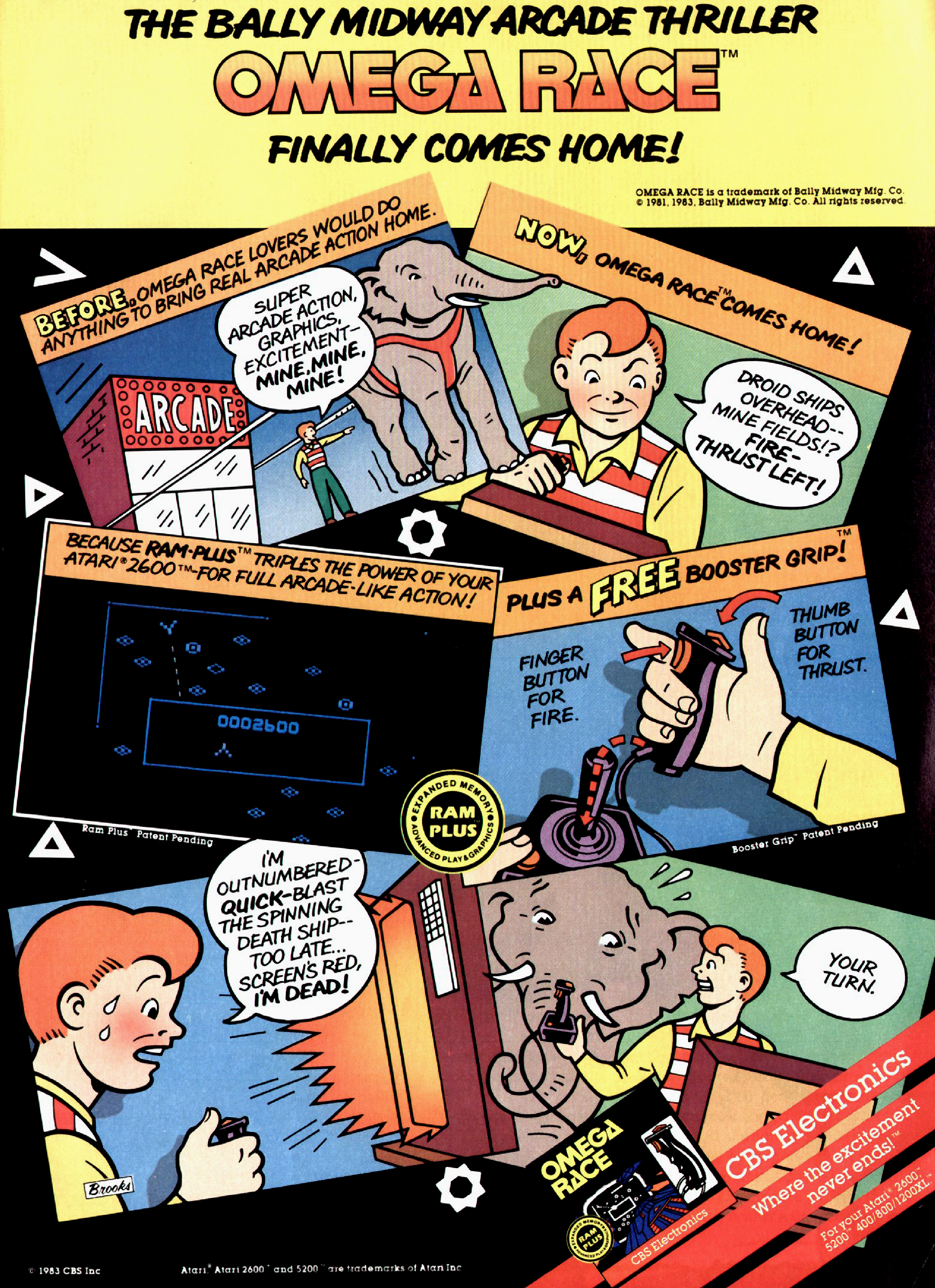
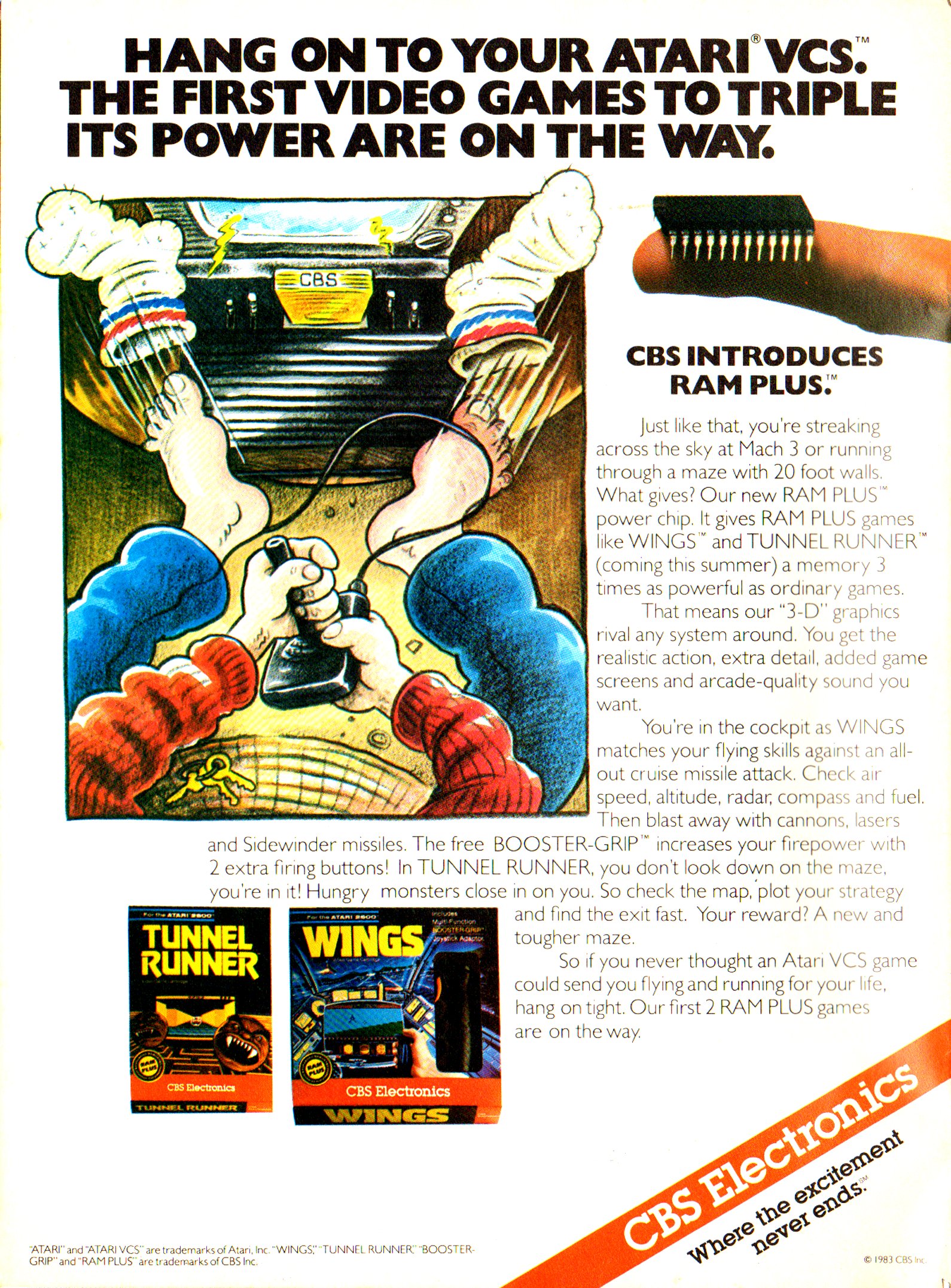
CBS Electronics called theirs RAM Plus, and it added 12K of ROM and 256 bytes of RAM. It was used in Omega Race and Tunnel Runner (Wings was to be the 3rd).
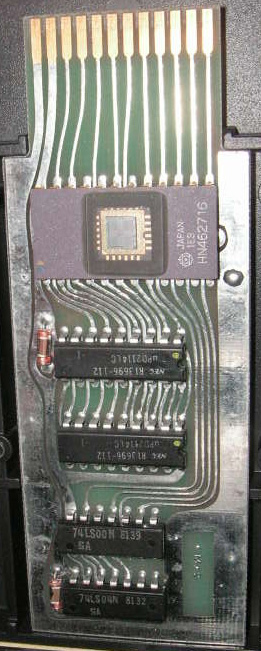
CommaVid's "Extended RAM" cartridge
CommaVid developed "Extended RAM" cartridges for Magicard and Video Life that offered 2K of ROM and 1K of RAM. According to a company ad, it "provides eight times the RAM available to a normal 2600 Video Computer System game." It was developed by Dr. John Bronstein,
who received patent 4,386,773 for it.
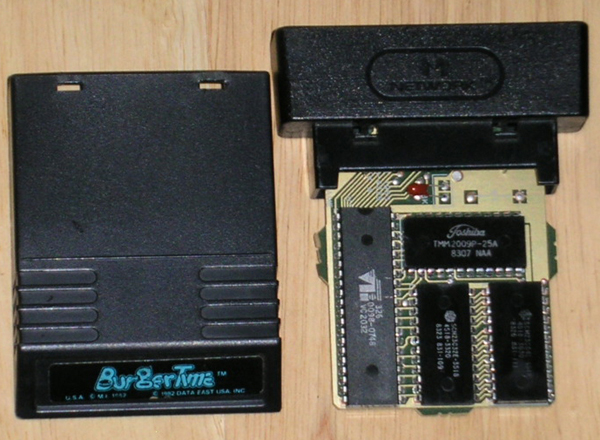
M Network's BurgerTime "Super Cartridge" game
Mattel/M-Network called theirs "Super Cartridges", which added up to 16K of ROM and 2K of RAM ("Big Game" was printed on the prototype carts), but BurgerTime was the only game they released that used it (In Search of the Golden Skull was to be another). The extra hardware was originally going to be released as a "Super Charger"-type module that would go between the system and cart, but poor sales of the
Intellivoice module prompted Mattel to put the hardware in the cartridge.
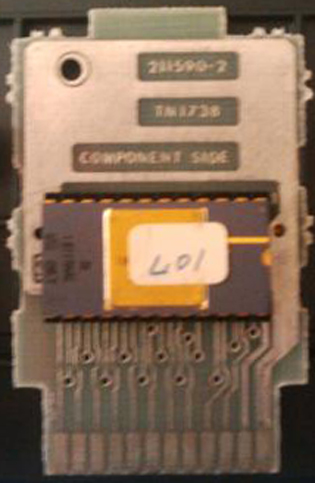
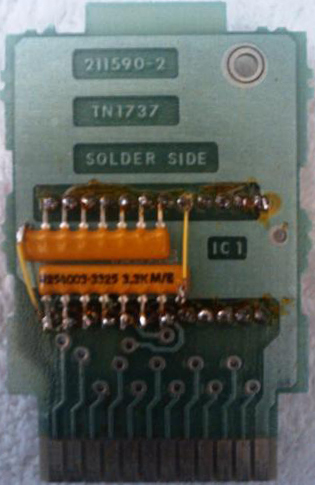
James Wickstead Design Associates developed the custom RAM/ROM chip, shown here on a Pink Panther prototype
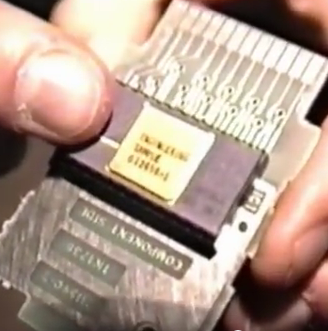
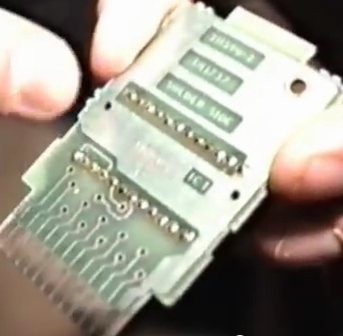
Photos of Steve Averitt's Pink Panther prototype showing the same pcb and ROM chip
(which is marked "ENGINEERING SAMPLE") but doesn't have the resistor packs on the bottom
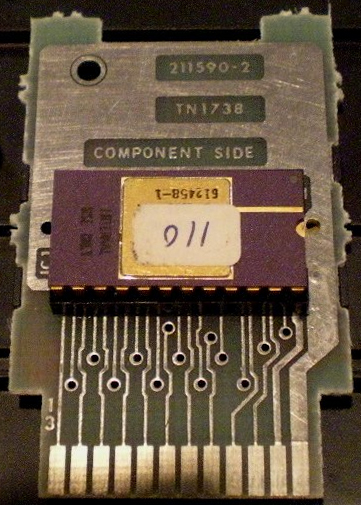
Photo of another Pink Panther prototype with a different-numbered label. Does the number mean
there were at least 110 chips+boards, or does it denote a different (later) version of the game)?
U.S. Games had a special "RAM/ROM" chip for their Pink Panther game (both developed by James Wickstead Design Associates), which added 8K of ROM and 2K of RAM, but the company went under before it was produced. NAP bought the Pink Panther game from them, along with the RAM/ROM chip. According to an interview with NAP's Bob Harris (in the Spring 2001 issue of Classic Gamer Magazine) NAP hired a company to fabricate the RAM/ROM chip , but unfortunately the new chips failed and the Probe 2000 division was shut down as a result. The same custom chip was also to be used for Coleco's Tarzan game.
The games that relied on these "super chips" were an improvement (visually) compared to anything that came before them (and in the case of the DPC, auditorily), so the advantage of using them was undeniable. They could even be considered early efforts towards the eventual development of co-processors.
Several companies developed what can be called "super cartridges" which allow for everything from larger and/or multiple games to low-end computer features such as online access and greater programming abilities. While most of these products never made it to market (which can be found listed HERE), the ones that were are described below.
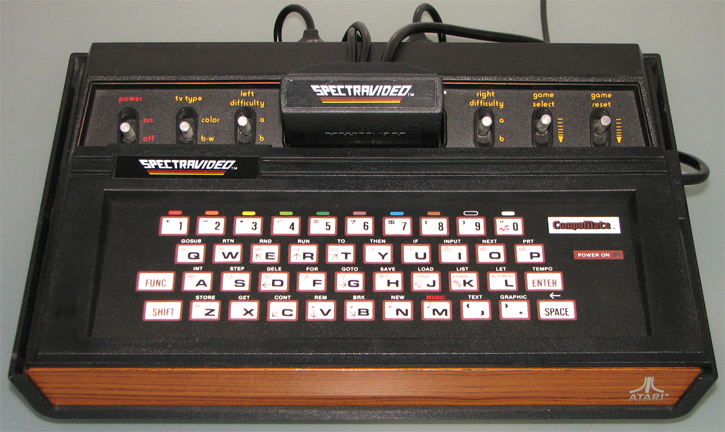
CompuMate (SpectraVideo) - This is a 42-key touch pad-style computer add-on that adds 16K ROM, 2K RAM, a 2-channel + 2 octave music composer, BASIC, and Magic Easel. The unit looks like a small keyboard connected to a cartridge, which has 2 cables that connect to the controller ports. It has 3 function/display modes: Text (which runs BASIC), Graphic (which runs Magic Easel), and Music. Magic Easel allows you to create photos (with up to 10 different colors) and animations (up to 9 frames) using the joystick). Originally sold for $79.99. This was once quite rare to find until a large quantity surfaced in Venezuela in 2010. There's also a German version made by Universum.
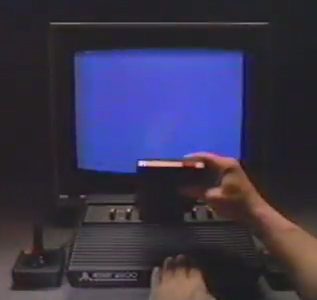
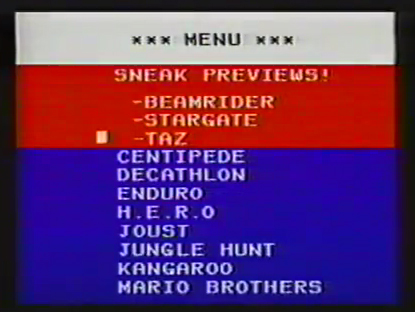
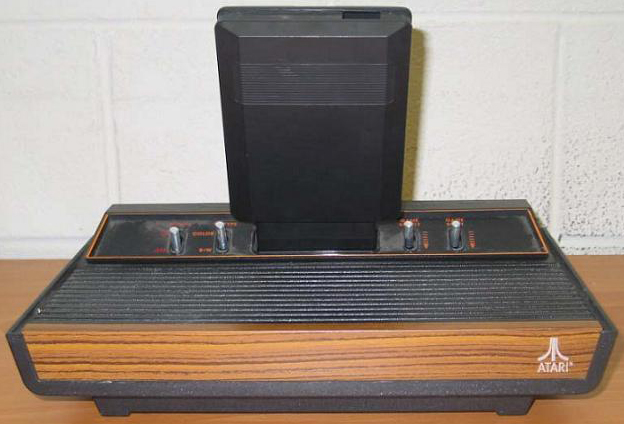
Electronic Pipeline (EPS) - A joint venture between Atari and Activision in late 1983 planned to sell wireless game cartridges with which users could select and play up to 40 different games each month for a low monthly subscription fee. A TV commercial was created for it, and the service was in alpha testing and a mere 4 days from installing the transmission equipment in the first test market when it was indefinitely postponed due to Warner's sale of Atari in 1984.
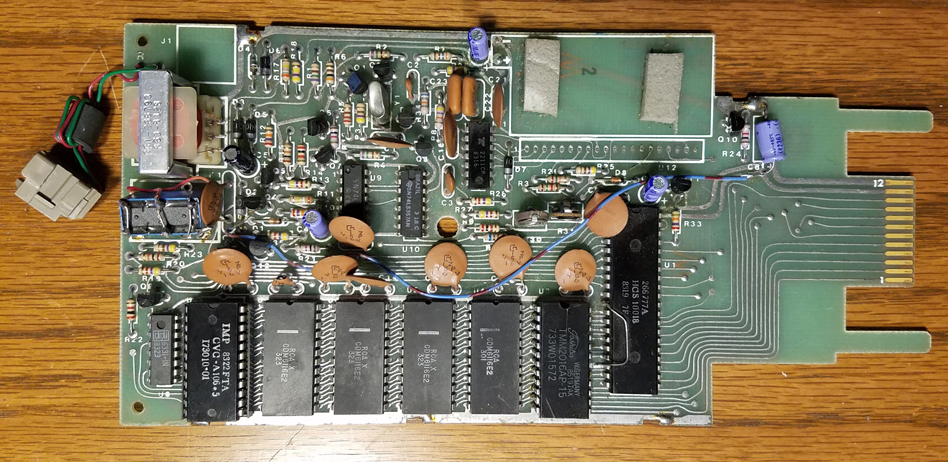
Production pcb (minus the 9v battery and hybrid
module, and with some alterations). Photo courtesy of Kevin Horton.
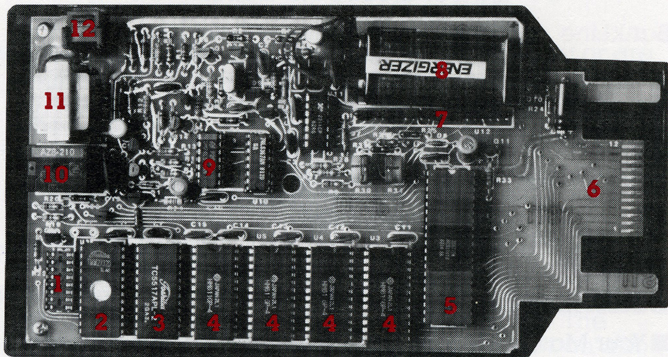
Prototype pcb shown in manual. It has an
EPROM instead of a mask ROM, and the PROM space has an empty socket.
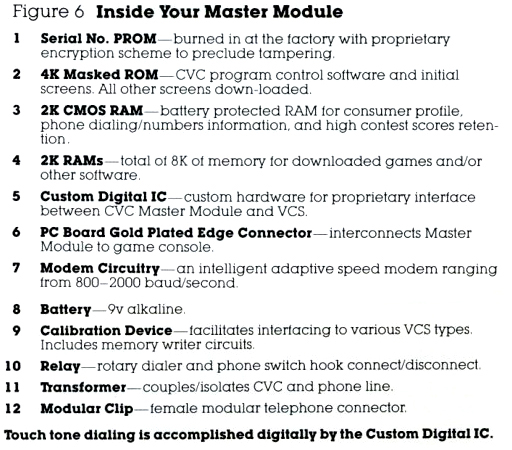
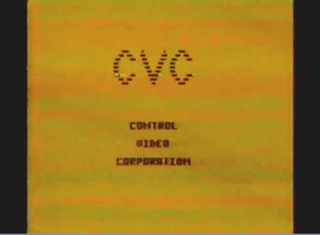
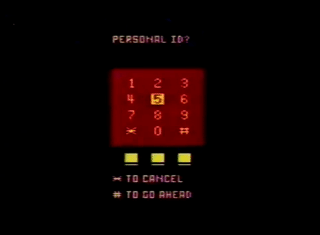
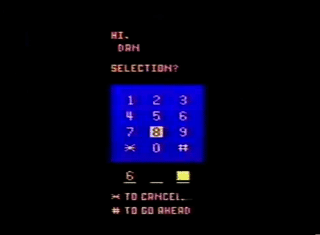
GameLine Master Module (CVC) - An interesting concept that arrived too late. By purchasing the GameLine and the monthly service, Atari 2600 owners could plug in and download the latest games via the Master Module and a telephone line. The complete kit contains the Master Module (an 8K RAM cartridge with internal 1200 baud modem), telephone connecting cord, a duplex T-adapter, owner's manual, registration guide, GameLine membership cards, and "temporary" game directory & instructions. Trivia: the GameLine system begat QuantumLink, also known as Q-Link, an online service for Commodore computer users, which begat America On-Line, the most successful online service ever. For more information, see Dan Skelton's article.
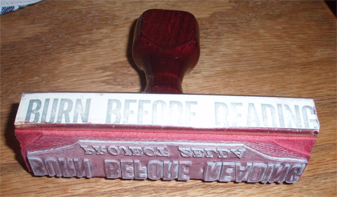
Project "Zelda" (Parker Brothers)
Parker Brothers planned to distribute games online with a special cartridge similar to the GameLine Master Module. Code-named "Project Zelda", the device was built and working in the lab when Parker Brothers decided not to pursue it further. Read my interview with Steve Kranish to learn more about it.
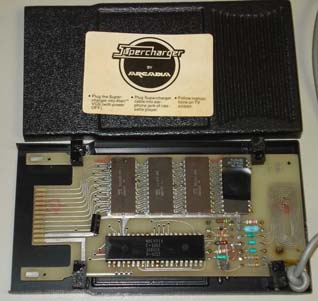
Supercharger (Starpath) (and knock-offs like Digitel's Digigame K7, Embracom Electronica's Telegame, VGS's Game Changer, and Splice's Comp K-7) - Originally released under the name Arcadia and later changed to Starpath, the Supercharger is an add-on device that improves the Atari VCS memory, graphics, and sound capability. The unit itself contains 6K RAM and 2K ROM. ROM is in top 2K and RAM is banked in lower 2K. Games were distributed on cassette tape. By plugging the Supercharger into the VCS and connecting its cable (with a standard 1/8" jack on the end) to a standard cassette tape player, games could be "loaded in" to memory. The Supercharger unit contains 2K of ROM, but more importantly it adds an additional 6K of screen RAM to the VCS (a huge improvement over the hardware's 128 bytes). Phaser Patrol was also included.
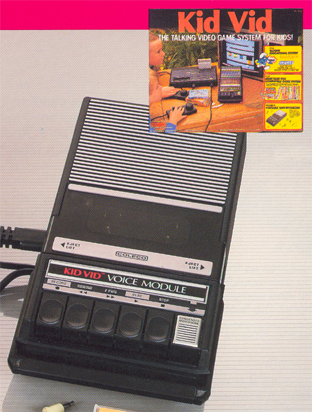
Kid Vid Voice Module (Coleco) - Released by Coleco in 1983, this is a cassette recorder with a cartridge interface. An additional wire connects the recorder to the joystick port. Voices and songs from the cassette instruct the player what to do on the screen. The tape shuts itself off automatically to allow the input. 3 cassettes (for the game Smurfs Save the Day) came in the package. Only one other title, Berenstain Bears, is compatible with this unit.
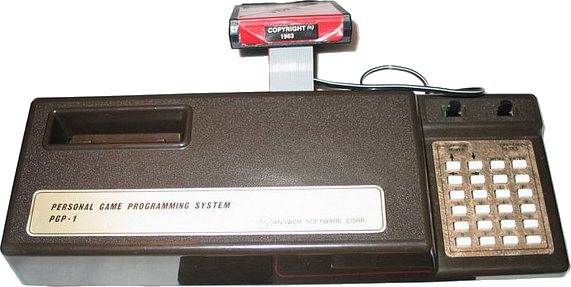
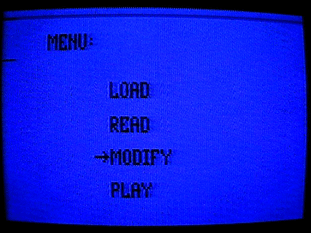
Personal Game Programming System (Answer Software) - Available directly through Answer Software for a short time, this peripheral allows you to change the code on existing games to your own liking, much like a Game Genie. It doesn't actually store the changes on the cartridge - the program is 'downloaded' into the PGP-1's memory, so all changes are temporary. Brown and gold with white keys, the unit sits on top of the Atari 2600. Two cables - one to the cartridge port and one to the power receptacle - connect it. Only a dozen were supposedly made, and most were likely sent to magazines for review. We know of at least 2 in existence - Al Backiel purchased 2 units, plus 4 or 5 programming manuals (to alter the code for 4 or 5 different games), for $500. Bill Sommerwerck coordinated the sale from Answer Software. Bill eventually sold his to Marco Kerstens, and Al sold his to John Hardie for $650, which is now in the CGE's museum collection. Historian Leonard Herman was given a private demon of the PGP-1 by Answer Software president Edward Tang, but was never offered a chance to buy it (but he did get a free copy of Malagai out of it).
The last 20 years has brought several advancements to the VCS with both hardware and software. Homebrew programmers, building on the foundation of knowledge that was produced during the system's official lifespan, have since produced their own cartridge pcbs and shells, and their own "super cartridges" and hardware peripherals. They have also developed new bank-switching methods (4A50, CDF, CDFJ) that allow for games larger than 32K, as well as new programming tricks. One such trick is Andrew Davie's Interleaved ChronoColour. This can be thought of as the 'next generation' of Bob Whitehead's "Venetian blinds", but is actually a variant of Jeff Potter's ColorView for the 800 computer. A 32-character text display was recently developed that can be applied to improved text adventure games, as well as with other applications. The potential capabilities of using BUS Stuffing - something the designers of the The Graduate computer add-on had developed - are very promising as well.
Below are some of the most-recent products that have been released independently.
Aria - An ARM-based board similar to the Melody that's used exclusively by Atariage for bankswitching schemes that legacy (EPROM-based) boards do not or cannot support (such as various SARA RAM schemes: F8SC, F6SC, F4SC).
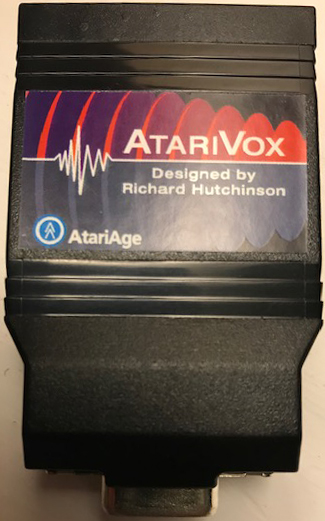
AtariVox (Richard Hutchinson) - A SpeakJet-based unlimited-vocabulary speech/sound synthesizer connecting to the Atari 2600/7800 console via the second joystick port. Also on-board, is 32K of non-volatile memory (EEPROM) for high score saves, configuration settings, etc. The high score table feature uses the I2C protocol. It comes as a fully built PCB with cable to connect to the Atari 2600/7800 (just plug in a set of PC speakers, headphones etc). Man Goes Down and LoopCart were the first 2 homebrew titles to support this. The version originally released by Richard Hutchinson in 2004 required an updated mod to add pull-up resistors for full compatibility with all games that use this. The version originally released by Atariage in late 2006 had to be recalled due to using the wrong EPROM. This was re-released again in 2010 (for the same price) and includes Vec Vox/Voice support.
Bank-switching -
Recent 'homebrew' bank-switching methods (and pcb designs) have allowed for
games as large as 1Mb:
0840 (Econobanking)
3F (Enhanced Tigervision style, up to 512K)
3E (3F with up to 512K of ROM, 256K of RAM)
3E+ - designed by Thomas Jentzsch
and derived from the DASH bank-switching scheme designed by Andrew Davie, which
in turn was derived from the 3E bank-switching scheme designed by Armin Vogl
which was in turn derived from the method used in Tigervision carts (link).
4A50 (no name 64K + RAM) - Toyshop Trouble was the first homebrew to use this.
Designed by "Supercat".
BF/BFSC (256K)
CDF - Bosconian was the first homebrew to use this.
CDF stands for Chris Walton, Darrell Spice Jr., and Fred X. Quimby. From
Darrell Spice Jr.: "CDF takes what we learned from using DPC+ for a number of
projects, and combines it with what we learned trying to get BUS Stuffing to
work. CDF has less overhead, so more ROM and RAM is available for the game,
while adding new features like digital sample support."
CDFJ - An extension of CDF. J (which stands for John Champeau) was
added when John put in an enhancement request for one of his games (link).
CTY - Chris Walton created this for Chertiry.
CU (Custom) - DPC+
DF/DFSC (128K)
EF (64K) - Designed for Homestar Runner.
EFSC (64K + RAM) - Designed for
Homestar Runner.
F4S (32KB with 128B SARA Super Chip RAM)
F6S (16KB with 128B SARA Super Chip
RAM)
F8S (8KB with 128B SARA Super Chip
RAM)
FA (12KB with 256B RAM+ RAM)
MC (Megacart)
SB (SuperBank) - based on either 0840 or F0. Allows for games as large as
1,024K (1MB). Designed by "Supercat".
X07 (64K) - Stella's Stocking was the first homebrew to use this.
Similar to EF.
More information about the different banks-witching methods can be found on Kevin Horton's website
and this
site.
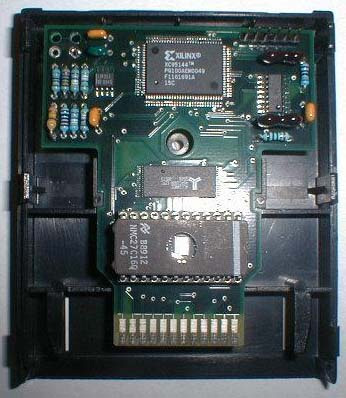
Cuttle Cart (Schell Electronics) - An interface cartridge with an audio cable (with a 1/8th male connector) for transferring files from an audio format (cassette, CD, or PC via a custom software program that converts BIN files and transfers them to the Cuttle Cart). Initially released in 2001 by Chad Schell, production was discontinued years ago and only 204 carts were produced.
DPC+ - An advanced version of Activision's DPC co-processor. DPC+ had been in development since at least 2010, with Fred X. Quimby and Darrell Spice Jr. largely responsible (LINK). They decided to use the extra resources offered with the Harmony to expand upon DPC's abilities (the ARM chip in the Harmony/Melody cartridge emulates Activision's DPC so it can play Pitfall II: Lost Caverns) and came up with DPC+. There's no actual ROM chip of DPC+; it's emulated in both the Harmony/Melody cart and Stella emulator. Work on “expanded DPC” started in March of 2010. The name was changed to “enhanced DPC” at one point before they finally settled on “DPC+" after Stephen Anthony requested they use a one-word name for it for the Stella emulator. The new features are even faster updating of sprites, better 3 voice music (the waveforms can be customized while the original DPC only used square waves), and even the ability to offload processing to the ARM chip in the Harmony/Melody. Some of the key things are:
Processing can be offloaded to a 70 MHz ARM during Overscan and Vertical Blank processing
24K (six 4K banks) for 6507 and ARM code
4K Display Data (initial state is stored in ROM, but working copy is in RAM so contents can be changed at run-time)
3-voice digital music with custom waveforms
Fast Fetch mode for 2 cycle reads of the DPC+ registers
Games like Space Rocks and Stay Frosty 2 were written using 6507 assembly (not batari Basic) and DPC+ with ARM. There’s no limit on how many sprites you can have, per se. For example, Darrell Spice Jr.'s Space Rocks game features 51, and his next game, Draconian, will feature 150!
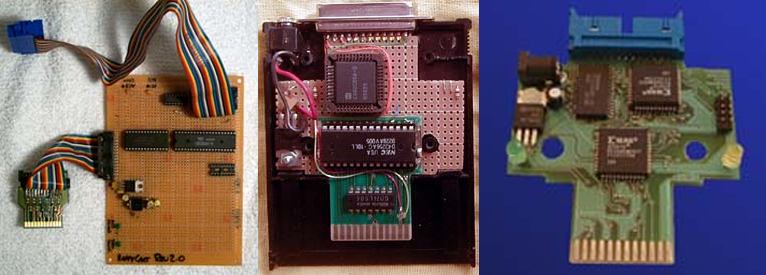
HappyCart BSW2000 - Stephen S. Richardson and Michael J. Andrews created this between 1998-1999 - years before the Harmony, but apparently only 4 prototype versions were ever made, and none were sold. The HappyCart BSW2000 allows you to play 2K, 4K, 8K (F8 bankswitch), 12K (FA bankswitch), and 16K (F6 bankswitch) ROM images on your real, existing, physical Atari 2600 console (VCS). In addition to the aforementioned bankswitch methods, the HappyCart supports emulation of Atari's SuperChip (needed for many games such as Millipede, Dig Dug, etc) and CBS RAM+ (needed for Mountain King, Omega Race and Tunnel Runner). See their website for more information.
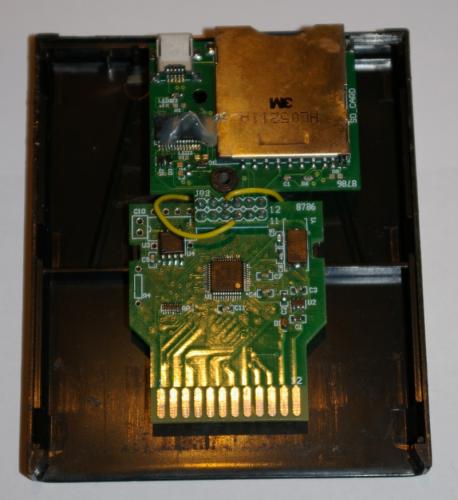
Harmony - Created by Chris Walton and Fred X. Quimby, it's a 32K flash cart that utilizes a Philips lpc210x ARM7 microcontroller and features 8K of RAM and an SD port for transferring files. A joystick or paddle can be used to select games from the built-in menu (it auto-detects which controller is plugged in); with Gemini or Sears Tele-Games Video Arcade II controllers, you have to hold the fire button down when powering up to disable the auto-detect and force it to read them as a joystick, since those controllers are a combo joystick+paddle and it will always detect it as a paddle. Unlike the Krokodile cart, the binaries may be of mixed type, and unlike the Cuttle Cart 2, you don't need a configuration file; the bankswitch type is auto-detected. You can also force a particular bankswitch type by changing the file extension. Updates to the cart's BIOS have allowed it to support custom bank-switching routines and co-processors such as DPC+. The cart also features a 5-cycle/DPC+ "Fast Fetch" mode for a faster TIA register update rate. 40-50 numbered pre-production (hand-assembled) Harmony carts were first released at the 2009 Portland Retrogaming Expo, at $80 each. Full release carts are cheaper and have a different label, and are available in both a standard edition (cart + b&w manual) for $50, or a deluxe edition for $75, which includes a color manual, USB-mini B cable, and 2GB SD card loaded with the programming software, drivers, online manual and demos of several homebrew games. In 2010 the prices were raised to $60 and $80 respectively. Fred Quimby states even at the higher prices, 600 carts would need to be sold before breaking even on development costs. Now available for $40. See this website for more info.
Harmony Encore - Again created by Chris Walton and Fred X. Quimby, this is an updated version of the Harmony to handle some of the newest homebrew bank-switching schemes. It's fully reverse-compatible with Harmony but offers 512k of ROM or RAM and 1M of EEPROM storage. It was designed with the goal that it will run fully 100% of Atari 2600 games, old and new. Initially available at the 2014 Northwest Classic Games Enthusiasts (NWCGE) show for $84.99; now available for $55. See this website for more info.
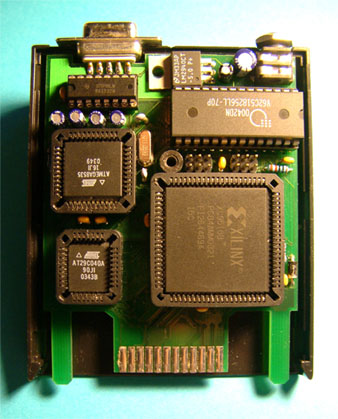
Krokodile Cartridge - Created by Armin Vogl, it's a 512K flash cart with a serial port for transferring files. It includes 32K of RAM to support "super chip" games. Unlike the Cuttle Cart, it can be used as a multicart and can store up to 127 4K games and run them via a built-in menu. See this website for more info.
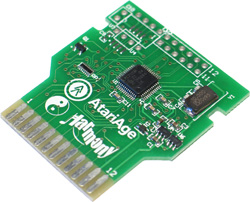
Melody - Basically a Harmony board w/o the USB + SD interface board. It contains the same Philips lpc210x ARM7 microcontroller and features 32K flash memory (which typically has a 10-20 year retention, and the spec sheet for it does state 20 years), which is used to store the game binary. The original boards had to be redesigned "in terms of fitment and electrical contact and RF", plus the original boards used tin, which was later replaced with gold. Harmony has a pair of decoupling diodes that separate USB power from console power. The original Melody had an extra diode and cap, for USB in case it were to be turned into a Harmony, so it worked. When these were removed for rev 1.0, (dubbed "Melody+", "Melody Enhanced", or "Melody Plus"), it created an incompatibility issue with some models. This version of the Melody includes support of DPC+ and was used in several homebrew games (The Byte Before Christmas, Chetiry, Mappy, Omicron, Pinata, Stay Frosty 2). Rev 2.0 of the Melody includes the parts that were removed in the last revision, thus resolving the incompatibility issues.
Atariage basically has a "monopoly" on these. Up until 2013 (LINK), they offered to sell copies of games with a Melody board for $5 more. The owner would then have the option to recoup some of their investment - they can send it back to receive 50% of the price for store credit towards another game. The Melody board uses flash memory, so it can easily + quickly be reprogrammed with another game w/o having to open the casing up (but the labels would have to be changed anyway, and changing the pcb wouldn't be an issue at that point). The board is really only advantageous to either programmers or Atariage (who can quickly produce cartridges w/o having to solder anything); the only real advantage (for buyers) would be if a game needed a revision due to a bug, but since most homebrew programmers allow anyone to playtest their games well before cartridges are sold, this issue rarely comes up. Information on how to reprogram Melody carts has yet to be shared with the community, so these pcbs remain inaccessible for reuse by anyone else.
The unofficial release of Pursuit of the Pink Panther by Roman Sharnberg uses a Melody pcb (PIC), so we know it supports JWDA's "RAM/ROM" chip. The official release of Boulder Dash in 2012 (in conjunction with First Star Software) uses a special version of the Melody board which contains 32K of ROM and 16K of RAM.
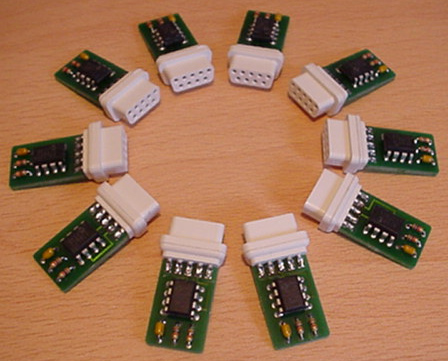
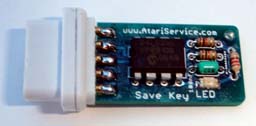
MemCard/SaveKey - Created by Richard Hutchinson and released in 2005, this is a small 32K EEPROM (the same part in the AtariVox) memory card that plugs into the joystick port and is used to store display settings, high scores and other data. The high score table feature uses the I2C protocol. Works directly with AtariVox-enabled games (auto detected). The SaveKey is the same as the MemCard, only by a different manufacturer and under a different name. The high score table feature uses the I2C protocol. There's also a SaveKey Plus that offers more storage. There's also a method to dump carts using this and a few other items, although the actual software needed hasn't been made public.
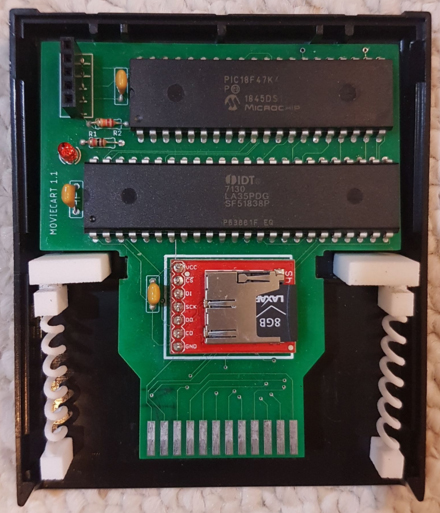
MovieCart - Designed by Rob Bairos, it allows the VCS to play video! It offers 80 x 192 resolution, 7-bit color, and 4-bit monaural video. More details can be found on his website.
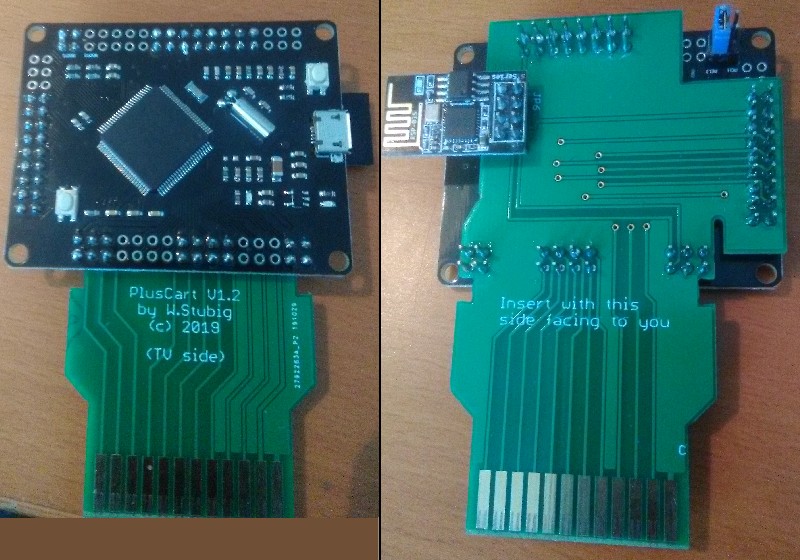
PlusCart(+) - Created by Wolfgang Stubig. Based off the UnoCart-2600, but instead of using an SD cart, it uses an ESP8266 to connect to a local WiFi Network and the Internet.
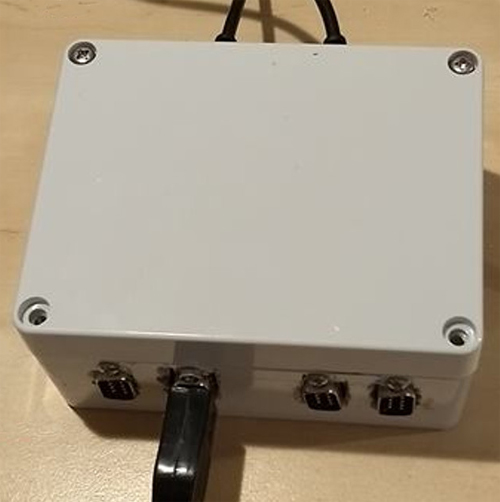
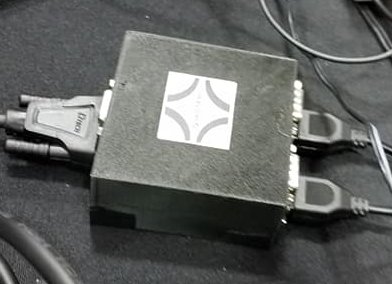
QuadTari
Developed by Nathan Tolbert as a solution to allow the use of 4 joysticks.
Originally called the QuadraStik, it was renamed Quadtari and a prototype
was first shown at the November 2017 PRGE shown. The device used both
joystick ports and was demonstrated with Quad-Tank, Quad-Joust,
and Bomb Defense (4-player Indy 500 was also being developed).
It was later refined (the original prototype created some RF interference) and adapted to only use one controller port, freeing
up the other for use with an AtariVox or MemCard/SaveKey. Wizard of Wor
Arcade was developed by John W. Champeau in conjunction with the
later design, and was the first homebrew game to support it.
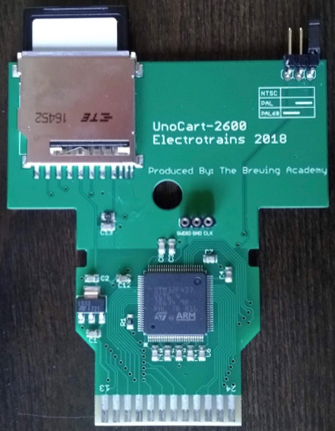
UnoCart-2600 (Electrotrains) - Created by Robin Edwards, the 2600 Uno cart is an open-source SD-card multicart for the Atari 2600. It features a 512K Flash ROM and 192K RAM, and a 168 MHZ ARM processor. There are 3 pins on the end label side that are used to configure it for NTSC, PAL, and PAL60. If none of them are jumpered, it's NTSC. If you jumper the left + center pins, it's PAL60. If you jumper the center + right pins, it's PAL. A version is also planned for stand-alone games (ala Melody). It can emulate most bank-switching schemes with ROM sizes up to 64k and RAM sizes up to 32k. It also comes in 3 different label styles (text, black, or silver). See this website for more info.